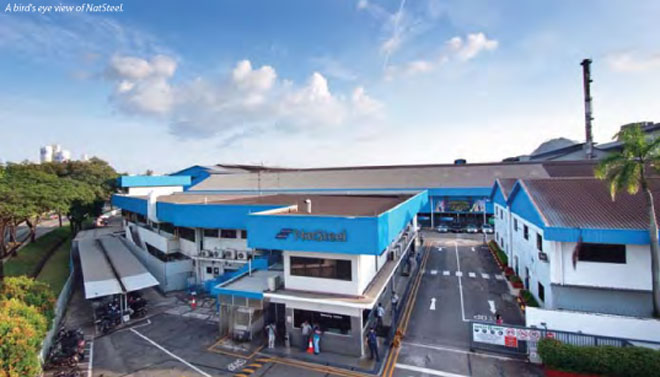 |
105th Annual Report 2011-2012 |
|
|
|
 |
Review of Operations |
|
South-East Asian Operations |
Home |
|
| |
NatSteel's Singapore operations recorded its best performance since coming into the Tata Steel Group, with significant achievements in safety and output. However, other than China and Singapore, NatSteel's units in Australia and Vietnam witnessed slow growth.
NatSteel's Electric Arc Furnace (EAF) operations boast one of the highest energy efficiencies in the world, with the EAF power consumption reaching 277 kWh/mt and total power consumption for the billet plant reaching 365 kWh/mt in the last quarter. These achievements enabled the Company's EAF and Rolling Mill to achieve the highest-ever production of over 761k tonnes of billet, bars and wire rod coils.
Riding on the strong construction demand in Singapore, NatSteel's downstream reinforcement business also achieved the highest-ever deliveries of nearly 421k tonnes to construction sites. This was a 16% growth over Financial Year 2010-11 and makes it the largest Downstream Reinforcement Solutions operation in the world.
The Singapore business is further increasing its volumes in value-added products from 65% currently to 80% of its overall sales, over the next two years. The operating units have embarked on IT-enabling of its operations, beginning from sourcing scrap to refining the product mix by increasing the share of finished value-added products, such as mesh, cages and cut and bend services.
China also recorded the highest-ever production and sales. Sales reached an all-time high of 540k tonnes, an increase of 9% over Financial Year 2010-11. Although demand in China tapered towards the second half of the year, the NatSteel Xiamen (NSX) operations held its own to achieve its best-ever performance. NSX is currently setting up its downstream reinforcement solutions operation, which would commence in Financial Year 2012-13.
Steel consumption in Vietnam shrunk by over 3% in Financial Year 2011-12, which severely affected operations in NatSteelVina (NSV), a joint venture with Vietnam Steel Corporation. Overall profitability and demand were also impacted by unprecedented inflation and interest rates. NSV revamped its rolling mill in April 2011 to increase its production capacity from 120k tonnes to over 200k tonnes facilitating improvement in its product mix. This is expected to make the business
robust and perform better on the back of an improved macroeconomic environment.
The Australian market continued to be adversely affected by poor construction demand and high competitive intensity. While the Company was able to maintain volumes at Financial Year 2010-11 levels, it saw a marginal drop in downstream sales and adverse affect on the profitability. Going forward, the business has taken on several initiatives to cut costs, improve manpower productivity and identify alternate sources of input feed.
Tata Steel Thailand (TSTH) recorded a decrease in the finished goods sales by 11% in Financial Year 2011-12 (1.14 mtpa) over Financial Year 2010-11 (1.23 mtpa). The shortfall was due to a drop in demand owing to the worst floods in the recorded history of Thailand, which affected sales in the second half of the year. The impact was so severe that the country recorded a GDP growth of mere 0.1% in 2011, a significant drop from the consensus estimates of 5%. However, the Company is implementing
a comprehensive turnaround strategy that has led to an improved product mix and higher price realisations over Financial Year 2010-11, leading to a turnover of Baht 26.2 billion (2% lower than Financial Year 2010-11). Floods and lower demand also led to a lower production of 1.16 mtpa in Financial Year 2011-12 (a drop of 9% over the previous year).

A bird's eye view of NatSteel.
The Company also decided to mothball its Mini Blast Furnace in view of the higher billet cost from the Hot Metal route versus the scrap route, and took a one-time expense hit on the bottom line due to mothball-related expenses.
During the year, TSTH branded its rebars as TATA TISCON and was able to build sales to maintain its leadership position with 24% of the market share on the strength of the TATA name, consumer pull and channel confidence in Tata-manufactured rebars. The Company also maintained its leadership position in special wire rods with a share of more than 40% despite the increase in imports from China, which has adversely affected the entire ASEAN region including Thailand.
To further enrich its product mix and to reduce the dependence on construction segment, TSTH made a
successful entry in the Special Bar Quality product to serve the lucrative automotive segment. Overall, the Company has improved its value-added mix from 23% in Financial Year 2010-11 to 28% in Financial Year 2011-12.
Going forward, Thailand expects to improve its GDP in 2012-13 on the back of recovery in automotive and pent up demand in construction segment. The focus of the Company is to drive the "turnaround" and return to profit. Accordingly, the focus is on operational excellence that includes savvy scrap procurement and a vigil on operating costs. In terms of market-facing initiatives, the Company will further strengthen its reach in regional markets to sustain leadership for Tata TISCON. Additionally, the Company has initiated work on the direct supply of Cut and Bend, ready-to-use products to sites. Consolidating its sales in Special Wire Rods and Special Bar Quality, the Company expects the high-end product mix ratio to improve.
|
|
|
|
|
|
|
|